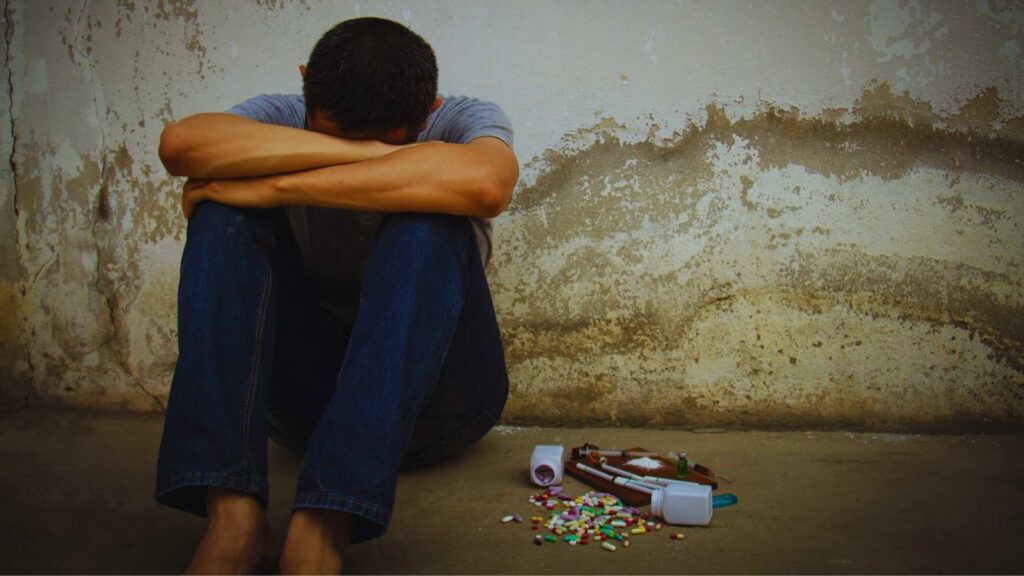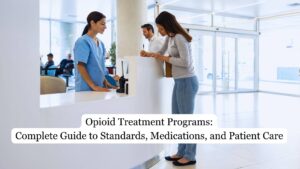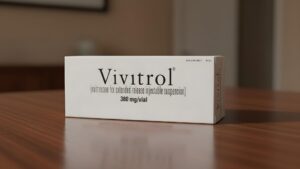Understanding Opioid Treatment Programs
An opioid treatment program is a specialized medical and behavioral service model designed to help patients recover from opioid addiction through structured care and consistent support. These programs combine counseling, medications, and supervision to stabilize individuals struggling with opioid use disorder. They provide comprehensive treatment that includes both medical and psychosocial components, following federal standards that ensure safety and quality.
A well-structured treatment program offers consistent dosing, therapeutic engagement, and progress tracking under licensed professionals. It’s not a quick fix but a continuous care approach that addresses opioid use, dependence, and relapse risk. Certified centers operate under the oversight of the Substance Abuse and Mental Health Services Administration, maintaining strict guidelines to protect patients and ensure effective opioid treatment outcomes.
For individuals with opioid dependence, participation in an OTP often marks the turning point between ongoing substance use and sustainable recovery. By combining evidence-based medicine with empathy, these centers give patients a real path to reclaiming stability and dignity.
Core Mission of OTPs
The central mission of every opioid treatment program is to provide structured, science-driven treatment that allows people to regain control over their lives. OTPs aim to treat opioid addiction as a chronic medical condition, not a moral failing. Their framework combines medication assisted treatment with counseling and behavioral therapy to improve health and life outcomes.
Each program must adequately evaluate a patient’s history and complete periodic assessments to tailor care plans. This helps clinicians identify changing needs, manage opioid cravings, and ensure measurable progress. The programs also educate participants about relapse prevention, overdose response, and safe medication use.
Ultimately, the goal is long-term recovery; where patients learn to manage triggers, stabilize their routines, and rebuild relationships. The mission is not just to stop drug use but to restore life function, emotional health, and hope.
The Scope of Opioid Use Disorder and Opioid Dependence

Opioid use disorder affects millions of Americans, encompassing a spectrum of behaviors and physical changes caused by long-term opioid use. It’s a chronic disorder that alters the brain pathways regulating reward, pain, and motivation. The medical definition recognizes that opioid dependence develops when the body adapts to the drug, requiring ongoing use to avoid withdrawal.
OTPs serve as a critical element of the healthcare response, delivering disorder treatment and counseling alongside medications like methadone or buprenorphine. The structured environment helps reduce illicit drugs use and lowers the risk of overdose.
By providing regulated opioid treatment program services, clinicians can adequately evaluate and manage each patient’s needs while monitoring co-occurring substance use disorders. This integrated method reflects a medical model of care focused on recovery rather than punishment.
Why Treatment Is Different From Detox
Detox is the first step in addressing opioid use, but it is only the beginning. Detox focuses on clearing opiates and other drugs from the body, while true opioid treatment through an opioid treatment program (OTP) provides the structured, long-term care needed for lasting recovery.
While detox manages withdrawal symptoms, OTPs deliver ongoing treatment services, including medications, counseling, and continuous support to help patients rebuild their lives and prevent relapse.
Here’s how they differ:
| Aspect | Detox | Opioid Treatment Program (OTP) |
|---|---|---|
| Primary Goal | Safely remove opioids from the body | Provide continuous medical and behavioral treatment |
| Duration | Typically lasts a few days | Can last months or years depending on progress |
| Medical Focus | Manage acute withdrawal symptoms | Stabilize brain chemistry with medications like methadone or buprenorphine |
| Therapeutic Support | Limited or none | Includes ongoing counseling, group therapy, and risk assessments |
| Outcome | Short-term relief from drug dependence | Long-term recovery and relapse prevention |
The difference matters. Detox ends drug use temporarily, but comprehensive opioid use disorder treatment transforms mindset, behavior, and biology. OTPs help patients move beyond surviving withdrawal and learn to live a fulfilling life without returning to the cycle of relapse.
Read how to sleep better during opioid withdrawal here: How to Sleep Better During Opioid Withdrawal
What Is Medication-Assisted Treatment (MAT)?
Medication assisted treatment (MAT) is the cornerstone of every opioid treatment program. It integrates FDA-approved medications with behavioral therapies to treat opioid use disorder effectively. MAT uses medications such as methadone, buprenorphine, and naltrexone to balance brain chemistry, reduce cravings, and block the euphoric effects of opioid misuse.
This approach addresses both the biological and psychological factors of addiction, giving patients a foundation for sustainable change. By managing withdrawal, minimizing relapse, and stabilizing brain function, MAT allows individuals to focus on counseling and rebuilding their life.
Key benefits of MAT include:
- Reduces withdrawal symptoms and opioid cravings
- Stabilizes patients for long-term participation in recovery
- Lowers the risk of relapse and overdose
- Improves treatment retention and engagement
- Restores emotional balance and physical health
In federally certified centers, the physician prescribes doses under strict supervision to prevent diversion and misuse. The program conducts periodic assessments to ensure safe and effective adjustments. When combined with therapy, MAT consistently produces better outcomes than medication or counseling alone. It is not replacing one drug with another; it is evidence-based treatment that restores stability, purpose, and opportunity for recovery.
How MAT Supports Opioid Use Disorder Treatment

Within an opioid treatment program, medication assisted treatment (MAT) remains the most proven approach to treat opioid use disorder and support lasting recovery. It addresses the biological effects of addiction while strengthening behavioral change through individual counseling and group therapy.
Each treatment program applies measurable methods to monitor patient development, medication tolerance, and progress. Regular periodic assessments allow clinicians to adjust medications safely and provide individualized care. Providers and behavioral specialists work together to coordinate disorder treatment services that build consistency, motivation, and accountability.
By stabilizing patients, reducing opioid cravings, and preventing overdose, MAT sets the standard for effective opioid treatment. Decades of medical research support its success, and the Mental Health Services Administration recognizes it as a best practice for measurable, long-term outcomes.
When managed with care, MAT helps individuals regain stability, rebuild relationships, and reclaim their sense of purpose in life.
Regulatory Oversight and Certification
Every opioid treatment program operates under strict federal and state regulation to ensure patient safety and consistent care. The Substance Abuse and Mental Health Services Administration (SAMHSA) sets national standards for opioid treatment, while states add their own oversight for licensing and quality.
The process is designed to ensure that every treatment program provides reliable services, qualified staff, and proper medication protocols. OTPs must also maintain patient confidentiality, clinical documentation, and ongoing staff education.
Key areas of oversight include:
- Facility licensing and inspection schedules
- Clinical guidelines for medication dispensing
- Counseling and health requirements for patients
- Staff credentialing and continuing education
- Regular reporting of outcomes and compliance audits
These regulations give patients confidence that the care they receive is evidence-based and professionally managed. Federal monitoring helps ensure that no patient is overprescribed or left without adequate medical and behavioral support.
Certified Programs and Compliance
Only certified opioid treatment programs can legally dispense methadone and certain other medications used in medication assisted treatment. Certification confirms that a center follows federal protocols, uses approved medications, and meets all reporting and training standards.
Each program must adequately evaluate its operations and complete periodic assessments that review patient safety, medication management, and recordkeeping. These reviews are not optional but required by both SAMHSA and the Drug Enforcement Administration to protect patients and prevent diversion.
Medications Used in Opioid Treatment
Medications are central to every opioid treatment program. They help the body stabilize, ease withdrawal symptoms, and allow patients to participate fully in counseling and behavioral therapy. The main medications approved for opioid treatment program services are methadone, buprenorphine, and naltrexone. Each works differently, giving providers options to match treatment to a patient’s needs and history of opioid dependence.
| Medication | Type | Primary Use | Key Benefit |
|---|---|---|---|
| Methadone | Full agonist | Long-term maintenance for severe dependence | Reduces cravings and withdrawal symptoms |
| Buprenorphine | Partial agonist | Flexible option for outpatient or clinic care | Lowers overdose risk and improves access |
| Naltrexone | Antagonist | Post-detox relapse prevention | Blocks opioid effects and supports abstinence |
These medications are prescribed under strict supervision and combined with counseling and social support to promote recovery. They are not quick fixes but tools that make sustained healing possible.
Methadone Maintenance
Methadone remains the longest-studied medication in opioid treatment. It fully activates opioid receptors to prevent withdrawal and reduce cravings without creating euphoria when properly dosed. Patients begin with daily visits, earning take-home privileges after stability and compliance are proven through risk assessments and periodic reviews.
Buprenorphine or Suboxone Maintenance Programs
Buprenorphine offers a more flexible option. Because it only partially activates receptors, it reduces withdrawal symptoms and cravings with a lower risk of misuse. It is often combined with naloxone to discourage diversion. Buprenorphine treatment can occur in specialized clinics or medical offices, allowing patients to balance care with work and family responsibilities.
Read more to learn Is Suboxone Addictive?
Naltrexone Maintenance Program
Naltrexone functions differently. It blocks receptors entirely, preventing opioids from producing euphoric effects. Available as a pill or monthly injection from a certified physician, it is best for patients who have completed detox and want a medication that carries no physical dependence.
Together, these medications give providers the ability to treat opioid use disorder safely, reduce overdose deaths, and improve long-term recovery outcomes.
See how to find a doctor who prescribes Vivitrol: Here.
Intake and Assessment Procedures

Before an opioid treatment program begins prescribing medications, every patient completes a detailed intake and assessment phase. This process ensures that providers adequately evaluate each individual’s medical history, substance use, and mental health. The goal is to identify the biological, psychological, and social factors that shape recovery.
During intake, patients meet with a multidisciplinary team that may include a physician, nurse, counselor, and case manager. This team reviews medical records, conducts interviews, and collects laboratory results to understand the patient’s overall health and readiness for treatment. The process helps determine which medication, dosage, and therapeutic supports are most appropriate for long-term success.
Intake activities generally include:
- A complete medical exam and substance use assessment
- Screening for mental health conditions and co-occurring substance use disorders
- Laboratory testing for infectious diseases such as hepatitis or HIV
- Evaluation of social determinants like housing, employment, and family environment
- Initial risk assessments for overdose, withdrawal complications, or relapse potential
Beyond collecting data, intake is also about setting expectations. Clinicians explain how medication assisted treatment works, discuss potential side effects, and outline counseling and behavioral therapy requirements. This early education gives patients a clear understanding of what recovery will involve.
The intake process builds a clinical foundation for personalized care. By combining objective testing with individual interviews, providers can design the safest and most effective treatment plan while maintaining compassion and respect for the patient’s experience.
Example of an Intake Schedule
An opioid treatment program typically follows a structured timeline during the first month of care. This schedule creates consistency and accountability while allowing flexibility for each patient’s needs.
| Day | Activity | Purpose |
|---|---|---|
| Day 1 | Medical and psychiatric evaluation | Establish eligibility and determine opioid dependence severity |
| Day 2 | Initiate methadone or buprenorphine treatment | Begin stabilization and monitor initial withdrawal symptoms |
| Day 3–7 | Counseling introduction and health education | Build trust and outline treatment expectations |
| Week 2 | Periodic assessments and medication adjustment | Measure progress and identify early challenges |
| Week 4 | Review by physician and treatment team | Confirm stability and adjust dosage or therapy plans |
By following this structure, treatment providers ensure that no patient begins medication without a thorough evaluation. It also helps the care team monitor progress, identify risks early, and adapt treatment strategies to support safe and lasting recovery.
Counseling and Supportive Therapies
Counseling remains a core part of every opioid treatment program. Medications address the biological side of addiction, but therapy addresses the emotional, social, and behavioral roots. Each treatment program incorporates both individual counseling and group therapy to strengthen engagement and accountability.
Effective counseling helps patients identify triggers, manage stress, and rebuild relationships. It also promotes understanding of relapse patterns and the importance of continued participation in treatment services.
Therapeutic approaches often include:
- Cognitive behavioral therapy (CBT)
- Motivational interviewing
- Relapse prevention training
- Family counseling sessions
- Peer recovery coaching
Combining counseling with medications allows treatment providers to address both the mind and body, leading to stronger outcomes and more lasting recovery.
Individual Counseling
Individual counseling offers private, personalized time between patients and licensed professionals. These sessions focus on self-awareness, emotional regulation, and personal goal setting. Counselors work to uncover the psychological factors behind opioid addiction while helping patients rebuild confidence and motivation.
Sessions may include:
- Exploring underlying trauma or stressors
- Setting short- and long-term goals for recovery
- Developing coping skills to prevent relapse
- Creating accountability plans and action steps
By providing a safe space for reflection, counseling individual sessions give patients the emotional foundation needed to sustain progress. Combined with medical oversight, these interventions contribute directly to reduced relapse rates and improved health outcomes.
Case management and counseling will often include how to grocery shop on a budget.
Family and Peer Components
Family and peer support play an essential role in sustained recovery. Family counseling helps loved ones understand opioid use disorder and how to support a relative in treatment without enabling addictive behavior. Peer support through recovery groups and community programs offers encouragement and shared accountability.
Ways family and peers strengthen recovery include:
- Providing consistent emotional support
- Reinforcing attendance and adherence to medication schedules
- Participating in educational workshops about substance abuse and treatment
- Encouraging communication and trust within the home
- Celebrating milestones in recovery
This collective approach turns treatment into a shared effort rather than an isolated struggle. It builds community resilience while reducing stigma around opioid addiction and disorder treatment services.
Addressing Withdrawal and Stabilization
Stabilization is the first milestone in any opioid treatment program. During this phase, clinicians focus on easing withdrawal while helping patients regain physical and emotional balance. Early stabilization helps reduce the risk of relapse and ensures that each patient begins recovery safely.
Withdrawal symptoms vary depending on the type of opioids used, dosage, and duration. Common symptoms include muscle pain, nausea, insomnia, anxiety, and fatigue. To manage these safely, providers use medications such as methadone or buprenorphine treatment while monitoring vital signs closely.
Withdrawal management involves three goals:
- Prevent medical complications related to sudden abstinence
- Reduce discomfort that interferes with participation in counseling
- Prepare patients for ongoing treatment services
Through constant observation and early stabilization, programs lower the chance of overdose and improve patient retention. Medical staff also educate patients on what to expect during this period so they can stay engaged and less fearful of symptoms as their bodies adjust.
Medical Supervision and Emergency Response
Continuous medical supervision is what keeps early treatment safe. Staff monitor vital signs, hydration, and medication response several times a day. Physicians make small adjustments to dosage to balance comfort and safety, while nurses record each patient’s progress in real time.
Every certified program is also required to maintain emergency readiness. Clinics keep naloxone and resuscitation tools on site to respond immediately to overdose or severe withdrawal complications. Patients are taught how to recognize early signs of medical distress and when to seek help after hours.
This structured level of care helps prevent crises, protects health, and gives patients a sense that their recovery is being guided by professionals who understand exactly what they are going through.
Integrated Medical and Behavioral Disorder Treatment Services

Recovery is not just about the body healing. It is about understanding what led to opioid addiction and learning new ways to manage stress, pain, and relationships. Integrated medical and behavioral disorder treatment services combine both sides of care under one plan.
Physicians oversee medications and overall health while therapists and case managers focus on emotional stability, habits, and social support. This coordination keeps patients from feeling like they are being passed from one office to another. It also ensures that every aspect of treatment works toward the same goal.
A well-integrated program includes counseling, medication management, education on healthy living, and help connecting to community resources. When medical and behavioral teams work together, treatment feels personal and balanced, giving patients the best chance at long-term recovery.
Chronic Pain and Co-Occurring Conditions
Many people entering opioid treatment programs originally began using pain relievers for legitimate medical reasons. Over time, tolerance and dependence developed, leading to addiction. Addressing pain effectively during recovery is essential, since untreated pain increases relapse risk.
Clinicians use non-opioid pain management strategies such as physical therapy, mindfulness training, and cognitive behavioral therapy. When medication is needed, physicians rely on approved non-addictive alternatives and closely monitor for misuse.
In addition to pain, many patients experience co-occurring conditions like anxiety, depression, or diabetes. These require simultaneous treatment by behavioral and medical specialists to ensure that progress in one area supports improvement in another. Treating the whole person strengthens both physical health and emotional stability.
The Role of Physicians and Providers
Physicians are at the center of every opioid use disorder treatment plan. They evaluate medical history, assess the patient’s current health, and prescribe medications that match individual needs. The physician’s job is not only to dose methadone or other approved medications, but to monitor the body’s response and adjust treatment when necessary.
Providers also help patients understand what is happening inside the brain as it begins to recover from addiction. Opioid use changes the way the brain processes pain and reward, and safe medical care helps those systems stabilize. This kind of education builds trust and makes patients more likely to stay involved in their own recovery.
Each team includes nurses, counselors, and case managers who share progress notes and observe behavioral changes. Together they make sure care remains consistent, coordinated, and compliant with all other requirements of certification and safety. That collaboration allows patients to receive medical attention, behavioral support, and life skills training under one roof.
Access, Cost, and Medical Insurance
Getting into treatment should never depend on a person’s income or location, yet for many people with opioid use disorder, access remains a barrier. Some delay care because they worry about cost or insurance coverage, while others are unsure how to find a qualified clinic. Programs that simplify entry make recovery possible for far more people.
Most opioid treatment services accept a range of medical insurance plans, including Medicaid and private providers. Some also offer reduced fees or payment plans for patients without coverage. Clear explanations of cost before treatment begins help patients focus on healing instead of worrying about how they will pay.
Common factors that affect total cost include:
- Frequency of counseling sessions and clinic visits
- Laboratory testing and medication adjustments
- The level of supervision required by the physician
- Additional supportive services such as transportation or child care
By increasing transparency, clinics remove unnecessary barriers and encourage patients to take the first step toward lasting recovery.
Improving Access
Expanding treatment access is one of the primary goals identified by the Mental Health Services Administration. Many new programs now combine in-person visits with telehealth sessions, allowing patients in rural areas to stay connected to their treatment team. This hybrid model also helps working adults who cannot attend daily clinic appointments.
Providers are finding creative ways to reach people who might otherwise be left out. Mobile units bring methadone and counseling services to remote communities, while partnerships with primary care offices integrate opioid use disorder treatment into standard health care. Each model improves convenience and normalizes recovery within the larger medical system.
Improving access also means addressing social determinants such as housing, employment, and family support. These factors strongly influence outcomes and must be considered part of the recovery process. When services respond to real-life barriers instead of treating addiction in isolation, patients have a far better chance of staying engaged and completing treatment.
Benefits and Outcomes of OTP Participation

When patients commit to an opioid treatment program and stay connected to care, the results are dramatic. Studies consistently show that medication assisted treatment reduces overdose deaths, improves health, and strengthens families. The combination of counseling and medication gives patients the structure they need to rebuild stability and independence.
Benefits often include improved employment rates, reduced criminal activity, and fewer hospitalizations for substance-related health problems. Many patients also report clearer thinking, lower anxiety, and better overall physical health once withdrawal symptoms fade and regular routines return.
A strong example of positive impact comes from clinics that track long-term outcomes. Programs that offer consistent follow-up after the last opioid use see higher recovery rates and fewer relapses. The reason is simple: consistent support keeps people connected to accountability and hope.
The benefits reach beyond individual patients. Communities gain safer streets, lower public costs, and stronger family systems when more people receive effective care. Each person who completes treatment becomes proof that recovery from addiction is not only possible but sustainable with the right mix of compassion and evidence-based medicine.
Addressing Stigma and Public Misconceptions
The stigma surrounding opioid use disorder still prevents many people from asking for help. Misunderstandings about addiction lead to shame and isolation when compassion is needed most. Education is the key to changing how society views treatment. Public awareness campaigns supported by the Mental Health Services Administration emphasize that recovery is not weakness but healing.
Programs that share real patient stories help communities see the difference between active substance abuse and active recovery. When people understand that medications like methadone or buprenorphine are legitimate medical treatments, more families begin to support loved ones in care. Reducing judgment allows patients to focus on rebuilding their lives instead of hiding from help.
Measuring Program Success
Every certified opioid treatment program tracks progress through both clinical and personal outcomes. Data includes patient retention, reduction in illegal drug use, and improvements in physical health. Success is not measured only by abstinence but also by stability in work, relationships, and self-care. Physicians and counselors use periodic assessments to evaluate satisfaction, emotional growth, and quality of life.
The Mental Health Services Administration encourages transparency in reporting results so the public can trust these services. When programs demonstrate accountability and compassion together, communities see measurable proof that opioid use disorder treatment works and that long-term recovery is achievable for anyone willing to participate fully.
How to Find the Right Opioid Treatment Program
Finding a treatment center begins with research and trust. Patients should look for a certified facility that provides counseling, medical oversight, and a full range of medications approved for opioid use disorder treatment. A licensed physician should be part of the team to ensure safe care and adherence to other requirements. Reliable programs clearly explain intake activities, costs, and medication options such as methadone or buprenorphine.
Patients can check online registries maintained by the Mental Health Services Administration to confirm that a program is legitimate. Choosing a center that fits personal needs improves commitment and raises the chance of successful recovery.
Resources and Additional Support
People seeking help for addiction can use the following national databases and organizations to find verified treatment options and recovery support:
- SAMHSA Treatment Locator – Comprehensive national database of certified opioid treatment programs and behavioral health providers
- SAMHSA National Helpline (1-800-662-HELP) – 24/7 free and confidential information service for individuals and families facing substance use or mental health issues
- Find Treatment – U.S. Department of Health and Human Services directory for locating nearby substance use disorder treatment centers
- VA Substance Use Disorder Programs – Search portal for veterans seeking specialized addiction and recovery care within the VA system
- 211.org – United Way’s national resource line connecting people to local treatment, housing, and recovery support services
- National Institute on Drug Abuse (NIDA) Resources – Research-based education, treatment referral links, and current opioid use disorder statistics
- Partnership to End Addiction Helpline – Text, call, or chat service offering personalized guidance and family support for addiction recovery
FAQs About Opioid Treatment Programs
How does an opioid treatment program differ from detox?
Detox focuses on short-term stabilization and the management of withdrawal symptoms. An opioid treatment program provides long-term recovery through medications, counseling, and ongoing medical supervision. Detox prepares the body for treatment, while the program teaches people how to live healthy, stable lives free from drugs.
Which medications are approved for treating opioid use disorder?
Three main medications are approved: methadone, buprenorphine, and naltrexone. Each works differently to reduce cravings, block opioid effects, or prevent withdrawal. Certified physicians determine which medication best suits a patient’s history, physical health, and stage of recovery.
How long do patients stay in medication-assisted treatment?
Duration depends on each person’s goals and response to care. Some remain in treatment for months, while others benefit from several years of support. Physicians and counselors review progress regularly to decide when patients can safely transition to maintenance or independent recovery.
Does insurance or Medicaid cover opioid treatment program services?
Yes. Most insurance plans and Medicaid cover counseling, medications, and related services. Patients are encouraged to verify coverage before starting treatment to understand any costs or co-payments. Many clinics also offer sliding-scale fees for those without insurance.
Can patients work or drive while in an OTP?
Most patients can continue normal activities once stabilized on medications. Physicians monitor dosage to prevent impairment and ensure safety. Stable participation in work, school, and family life is a sign that recovery is progressing effectively.
What are the success rates of opioid treatment programs?
Success varies by individual, but long-term studies show that patients who remain engaged in counseling and medication management experience far fewer relapses and overdoses. Programs that emphasize ongoing support and accountability deliver the most consistent outcomes for sustained recovery.






